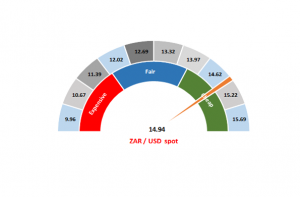Figure 1: Rand vs US dollar gauge:

Source: Anchor
We have seen the perfect storm building for the rand over the past two weeks. Eskom’s woes have been public knowledge for a while, however, by announcing an increased bailout for the state-run utility, Finance Minister Tito Mboweni has basically admitted that the rot is far worse than was originally thought. The rating agencies have unequivocally stated that this news is credit negative for South Africa (SA), whilst Fitch went as far as downgrading SA’s outlook from stable to negative. All of the above has clearly been rand negative, with the currency coming under increasing pressure.
Historically, poor domestic factors have been counter balanced by positive global considerations. Unfortunately, this has not been the case over the past two weeks. The on-again, off-again trade war between China and the US has once again flared up. The opening salvo was (again) fired by US President Donald Trump who implemented a 10% tariff on an additional $300bn worth of US imports from China. The rand came under pressure as a result of this move. China’s response was equally swift, with the Chinese government announcing that it will no longer import US agricultural produce, heaping further pressure on the rand.
In summation, we find ourselves back in a situation where the rand is trading at just below R15/$1 and is, once again, oversold on any historic metrics or PPP measures. The rand has basically been the victim of a perfect storm. At these levels we would normally consider reducing our holding of US dollars because some elements of the storm will subside. Unfortunately, we also know that this can take time and the rand can easily remain oversold for the next three years, while domestic politics and Trump’s need to show his supporters benefits from the trade war persist. We are looking to take some profits on the dollar positions that we hold, but in small increments over time. We underscore that the current situation may get worse before it gets better.
Figure 2: Actual ZAR/$ vs rand PPP model:

Source: Bloomberg, Anchor




